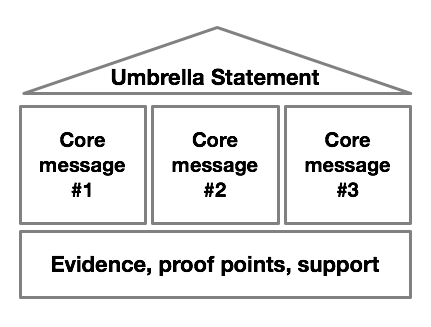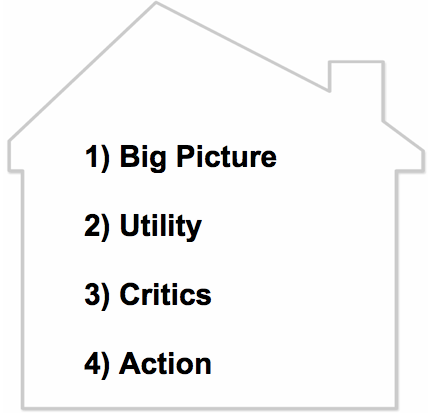Getting your message across with a Message House
Message Houses are a simple but effective tool for helping your teams stay on message in their marketing communications across different channels. They can be applied not only for general company marketing and brand positioning, but also for other projects (such as events and conferences) and even for the messaging of an organization as a whole.
You might have seen Message Houses that look like the one in the image below: with an 'umbrella statement' inside the roof, three rooms underneath (each containing a different 'core message'), and with a first floor full of 'evidence, proof or support.'
Let's call it the 'multi-room Message House'.
The idea is to have the contents of your Message House inspire all other communications. Consultants like to tell their clients: 'Stay inside the Message House, and you'll be safe!'
At the Message House Group, we have developed a simpler Message House style. It features only four short messages and places all of them inside a single 'room'.
The messages are always titled 'big picture', 'utility', 'critics' and 'action'.
Let's call it the 'single-room Message House'.
Here are three reasons why we have arrived at this simpler solution:
-
1. A structured approach to generating messages
The multi-room Message House requires users to come up with what they deem the three most important core messages for their project. I must admit that this was pretty much the way I used to go about determining my messages. I’d wonder: 'What’s the most important message?' and 'What's the second most important message?' and the
third-most, and so on.
Instead of just meditating on the notion of importance, and hoping that suitable messages will then form in your mind, we now use a more structured approach that generates core messages by asking a standard set of four questions:
- 1. 'What’s the big picture?'
The answer speaks to the vision. Why does the project or product matter? It inspires, gives people goosebumps. It points to something bigger than us.
'We help you save our planet' is a good example.
- 2. 'What’s in it for them?'
This 'Utility Message' gets across what is useful to your audience.
An example: 'Our shaver now lasts three times as long.'
- 3. 'What is the most likely criticism?'
Find the answer, and then blunt that criticism with a positive message. That’s your 'Critics Message'.
For instance, if critics say, 'this is too difficult,' then your positive Critics Message is:''It’s easy.'
- 4. 'What do you want your audience to do?'
Call the answer the 'Action Message'.
Often, it will be something like: 'Go to Web site xyz to get a discount now.'
(On our Web site you can find additional Message House examples.)
The four standard questions provide a useful agenda for team meetings in which you want to generate messages for a brand or a project. We have found that this structured approach leads to better messages.
Multi-room Message Houses tend to pack too much information, since they encourage you to include proof points, supporting materials and evidence into the space on the bottom.
The single-room approach leads to briefer amounts of text by seeking only four messages.
We advise to put proof points, and supporting materials such as answers to dicey questions and FAQ-style information into separate documents that complement your Message House.
Here is one reason why such brevity is useful: When you introduce the Message House concept to your organization, ideally, it will catch on as an organizational habit and elevate the role of messaging not just for the project at hand, but in general.
Keeping Message Houses short helps a great deal with creating this habit. The shorter they are, the more likely an organization’s staff will like them and keep asking for them.
Also, when time is scarce (say, just before a speech or a media interview) your spokesperson will be more inclined to glance over a concise set of messages, as opposed to a densely packed document. Simpler Message Houses get used more reliably!
Again, this does not mean you don’t need proof points, supporting materials, and the like. But the idea is to put them into separate documents so we get the benefit of having one easily digestible core document.
Less is more!
-
3. The practical matter of copy and paste
This last point may sound mundane, but it matters: The single-room Message House template makes it easy to pluck its contents by copying and pasting all the messages out of its single room in a single step.
This is useful when you want to send the messages as 'pure text' to someone who cannot or does not want to view them inside an attached Word or PDF document.
So, there you have it. The three reasons why we use the simpler message house approach: Structure, brevity and practicality.
You can download a free Message House template and eBook, check out instructional videos and learn more about our method at www.messagehouse.org.

Thanks to
Marc Fest for sharing his advice and opinions in this post. Marc is founder of
The Message House Group. You can follow him on
Twitter or connect on
LinkedIn.





 Thanks to
Thanks to 



